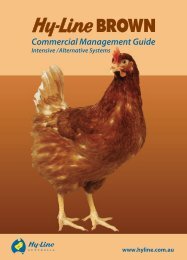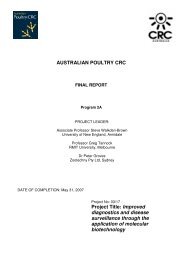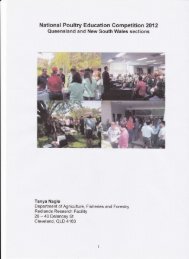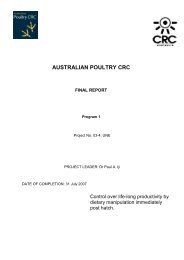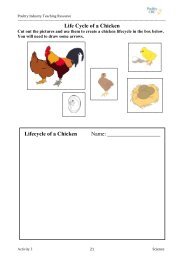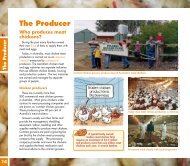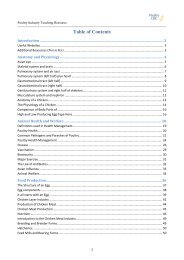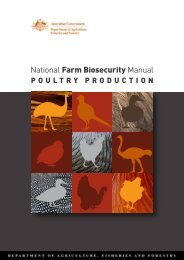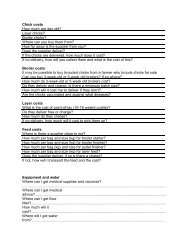AUSTRALIAN POULTRY CRC - Poultry Hub
AUSTRALIAN POULTRY CRC - Poultry Hub
AUSTRALIAN POULTRY CRC - Poultry Hub
- No tags were found...
Create successful ePaper yourself
Turn your PDF publications into a flip-book with our unique Google optimized e-Paper software.
The similar symptoms shown by both fowl cholera and spotty liver suggest that it is possible someflocks reported as dying of fowl cholera are actually suffering from spotty liver (although the cause ofthe condition is not clear, but Campylobacter jejuni has been implicated as the aetiological agent) andvice versa. This would mean Queensland, New South Wales and Victoria could all have spottyliver/fowl cholera as one of their major causes of mortality. It was also found that 80 – 100% of thetime that producers determine the cause of mortality on their farm and with the symptoms of the twoconditions being similar they could report the one they are more familiar with.Queensland and Victoria had problems with predators (foxes/crows and dogs/hawks, respectively)with Victoria also recording heat stress as an important cause of mortality. The heat stress result wasinteresting with temperatures in Queensland, New South Wales and South Australia generallyconsidered higher than Victoria. It is possible in these states where high temperatures are more thenorm; producers could employ measures in their sheds to help combat this problem (fans, foggers).Another possibility is that it is the extremes of temperature that are the problem with birdsacclimatised to a milder temperature suddenly experience a very hot day/week causing heat stressmortality (Daniel and Balnave, 1981).Egg peritonitis, prolapse/protusion, cannibalism and vent pecking were all seen as important causes ofmortality in all states. Therefore the main differences between the states in causes of death were fowlcholera and spotty liver and heat stress in Victoria.Epidemiological SurveyFlock sizes of the five farms ranged from 1500 – 3500 with all hens allowed to range in daylight hoursregardless of weather conditions. All farms had conventional sheds made of steel/colourbond orcorrugated iron, with sheds fixed in one location. Individual nest boxes were used on all farms withtwo farms having wooden nest boxes, two with plastic and one metal nest boxes (Figure 4). All farmsprovided perches for their hens (Figure 5).Figure 4: Example of individual plastic nest boxes in a free range shed.©The State of Queensland (DPI&F) 2007Hens in the survey sheds were Bond Brown, Hyline Brown and Bond Black with all rearing on-farmon the floor (Figure 5 and 6). All hens were placed in laying sheds between 12 – 16 weeks withpullets allowed to start ranging between 3 – 6 weeks of age. Three of the five flocks were under a 16:8hr lighting regime, with one flock beak trimmed at 14 weeks.All farms undertook regular rodent baiting and only one farm did not undertake regular worming ofthe flock. All farms had dedicated footwear and signage as their biosecurity measure with two farmsalso having visitor sign-in books and one farm a stand-down period. All farms vaccinated their flocksfor IB, Marek‟s, NDV, fowl pox, MG, EDS, fowl cholera and MS. Two farms also vaccinated against15



